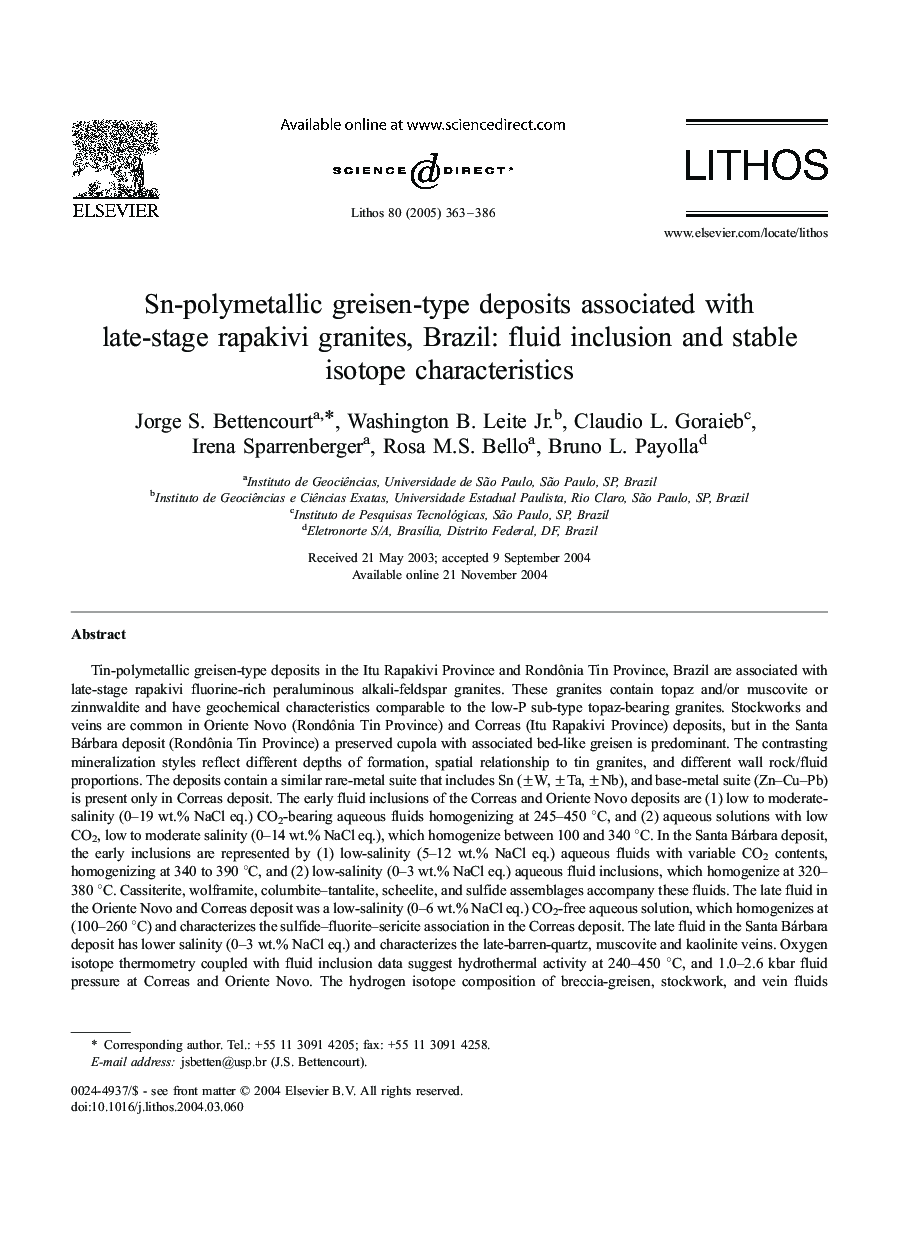| کد مقاله | کد نشریه | سال انتشار | مقاله انگلیسی | نسخه تمام متن |
|---|---|---|---|---|
| 9532113 | 1638794 | 2005 | 24 صفحه PDF | دانلود رایگان |
عنوان انگلیسی مقاله ISI
Sn-polymetallic greisen-type deposits associated with late-stage rapakivi granites, Brazil: fluid inclusion and stable isotope characteristics
دانلود مقاله + سفارش ترجمه
دانلود مقاله ISI انگلیسی
رایگان برای ایرانیان
کلمات کلیدی
موضوعات مرتبط
مهندسی و علوم پایه
علوم زمین و سیارات
ژئوشیمی و پترولوژی
پیش نمایش صفحه اول مقاله

چکیده انگلیسی
Tin-polymetallic greisen-type deposits in the Itu Rapakivi Province and Rondônia Tin Province, Brazil are associated with late-stage rapakivi fluorine-rich peraluminous alkali-feldspar granites. These granites contain topaz and/or muscovite or zinnwaldite and have geochemical characteristics comparable to the low-P sub-type topaz-bearing granites. Stockworks and veins are common in Oriente Novo (Rondônia Tin Province) and Correas (Itu Rapakivi Province) deposits, but in the Santa Bárbara deposit (Rondônia Tin Province) a preserved cupola with associated bed-like greisen is predominant. The contrasting mineralization styles reflect different depths of formation, spatial relationship to tin granites, and different wall rock/fluid proportions. The deposits contain a similar rare-metal suite that includes Sn (±W, ±Ta, ±Nb), and base-metal suite (Zn-Cu-Pb) is present only in Correas deposit. The early fluid inclusions of the Correas and Oriente Novo deposits are (1) low to moderate-salinity (0-19 wt.% NaCl eq.) CO2-bearing aqueous fluids homogenizing at 245-450 °C, and (2) aqueous solutions with low CO2, low to moderate salinity (0-14 wt.% NaCl eq.), which homogenize between 100 and 340 °C. In the Santa Bárbara deposit, the early inclusions are represented by (1) low-salinity (5-12 wt.% NaCl eq.) aqueous fluids with variable CO2 contents, homogenizing at 340 to 390 °C, and (2) low-salinity (0-3 wt.% NaCl eq.) aqueous fluid inclusions, which homogenize at 320-380 °C. Cassiterite, wolframite, columbite-tantalite, scheelite, and sulfide assemblages accompany these fluids. The late fluid in the Oriente Novo and Correas deposit was a low-salinity (0-6 wt.% NaCl eq.) CO2-free aqueous solution, which homogenizes at (100-260 °C) and characterizes the sulfide-fluorite-sericite association in the Correas deposit. The late fluid in the Santa Bárbara deposit has lower salinity (0-3 wt.% NaCl eq.) and characterizes the late-barren-quartz, muscovite and kaolinite veins. Oxygen isotope thermometry coupled with fluid inclusion data suggest hydrothermal activity at 240-450 °C, and 1.0-2.6 kbar fluid pressure at Correas and Oriente Novo. The hydrogen isotope composition of breccia-greisen, stockwork, and vein fluids (δ18Oquartz from 9.9â° to 10.9â°, δDH2O from 4.13â° to 6.95â°) is consistent with a fluid that was in equilibrium with granite at temperatures from 450 to 240 °C. In the Santa Bárbara deposit, the inferred temperatures for quartz-pods and bed-like greisens are much higher (570 and 500 °C, respectively), and that for the cassiterite-quartz-veins is 415 °C. The oxygen and hydrogen isotope composition of greisen and quartz-pods fluids (δ18Oqtz-H2O=5.5-6.1â°) indicate that the fluid equilibrated with the albite granite, consistent with a magmatic origin. The values for mica (δ18Omica-H2O=3.3-9.8â°) suggest mixing with meteoric water. Late muscovite veins (δ18Oqtz-H2O=â6.4â°) and late quartz (δ18Omica-H2O=â3.8â°) indicate involvement of a meteoric fluid. Overall, the stable isotope and fluid inclusion data imply three fluid types: (1) an early orthomagmatic fluid, which equilibrated with granite; (2) a mixed orthomagmatic-meteoric fluid; and (3) a late hydrothermal meteoric fluid. The first two were responsible for cassiterite, wolframite, and minor columbite-tantalite precipitation. Change in the redox conditions related to mixing of magmatic and meteoric fluids favored important sulfide mineralization in the Correas deposit.
ناشر
Database: Elsevier - ScienceDirect (ساینس دایرکت)
Journal: Lithos - Volume 80, Issues 1â4, March 2005, Pages 363-386
Journal: Lithos - Volume 80, Issues 1â4, March 2005, Pages 363-386
نویسندگان
Jorge S. Bettencourt, Washington B. Jr., Claudio L. Goraieb, Irena Sparrenberger, Rosa M.S. Bello, Bruno L. Payolla,